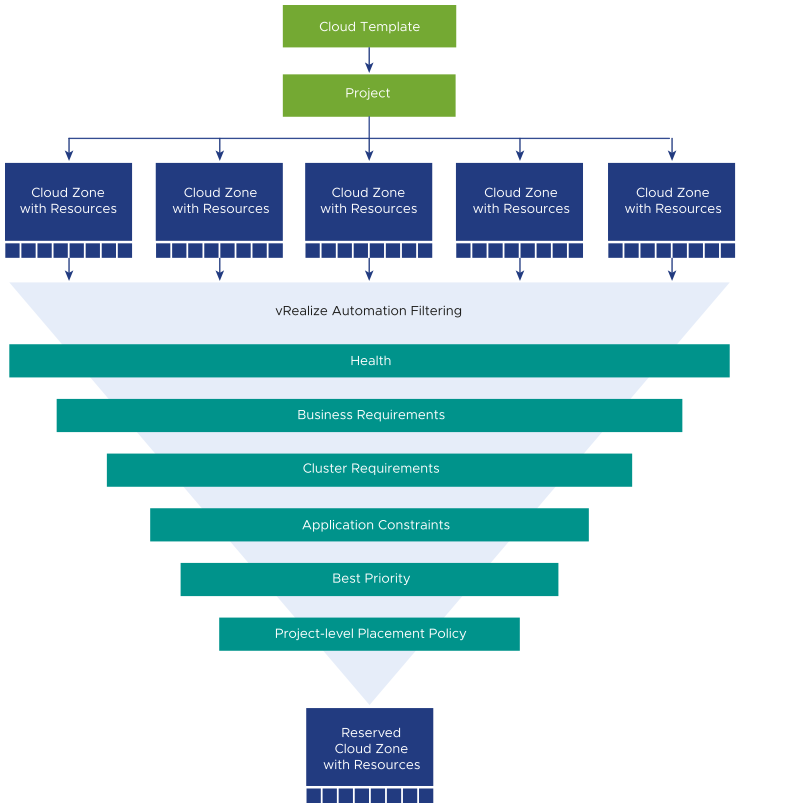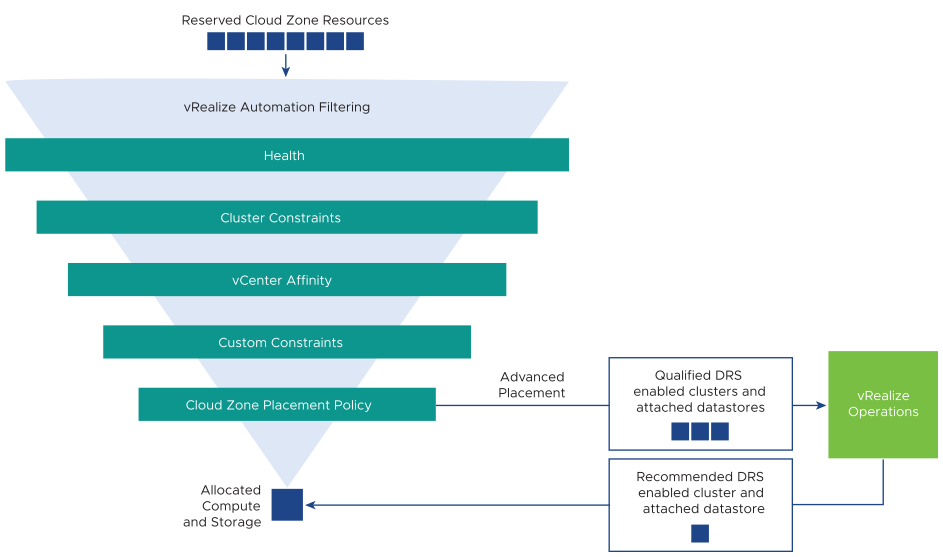To find the best infrastructure on which to place a deployment, VMware Aria Automation makes several filtering decisions. VMware Aria Automation integration with VMware Aria Operations may further refine the placement decision.
VMware Aria Operations can help to optimally place workloads provided that you have enabled the Advanced placement policy option in your vSphere based cloud zones.
In addition, the vSphere cloud accounts for the cloud zones must be monitored by VMware Aria Operations.
Phase 1: Reservation
The VMware Aria Automation reservation phase is the same whether or not you enable Advanced placement with VMware Aria Operations.

- Reservation starts with a cloud template linked to a project. That project is in turn linked to cloud zones.
- The cloud zones consist of compute resource hosts, pools, and clusters, and attached storage.
Initially, any cloud zone in the project may be a potential placement target.
- VMware Aria Automation filters out cloud zones that don't have enough healthy resources for the deployment.
For example, if too many resources are powered off or in maintenance, that cloud zone is filtered out.
- VMware Aria Automation filters out cloud zones that can't meet business requirements.
For example, the deployment might exceed a pricing or budget limit for the zone.
- VMware Aria Automation filters out cloud zones that can't meet cluster requirements.
For example, the cloud zone resources might have CPU or memory usage limits that are too low for the deployment.
- VMware Aria Automation filters out cloud zones that have no affinity with application constraints.
Affinity requires that cloud template or project-level constraint tags match capability tags found somewhere in the cloud zone resources.
For example, if the cloud template or project includes a storage constraint to use storage tagged
pci, a cloud zone where none of the storage resources have that capability tag would be filtered out. - VMware Aria Automation selects cloud zones with the best provisioning priority.
- If the project-level placement policy is something other than Default, VMware Aria Automation selects a cloud zone that supports the non-default placement policy.
In this release, Spread is the only non-default. Spread distributes the load by selecting the cloud zone with the lower ratio of virtual machines to hosts. Default simply deploys to the first available zone.
The project placement policy is only a factor during the cloud zone reservation phase. It has no effect on, nor relation to, the cloud zone placement policy in the allocation phase.
When finished, the reservation phase selects one cloud zone and its resources. VMware Aria Automation reserves the first available zone that remains qualified after passing the preceding filters.
Phase 2: Allocation
VMware Aria Automation inspects the reserved cloud zone compute resources and linked storage.

- Within the cloud zone, VMware Aria Automation filters out resources that are in a maintenance or powered-off state.
Note that there are still enough healthy resources for the deployment. Otherwise, the entire cloud zone would have been filtered out during the reservation phase.
- VMware Aria Automation filters out resources that don't match cluster-level constraints found in the cloud template or project.
For example, a resource in the cloud zone might be tagged
testunder .If the cloud template or project includes a constraint tag to use a
devresource, thetestresource is filtered out.In addition, storage or network profiles in the cloud zone might be tagged in ways that don't match cluster-level storage or network constraints in the cloud template or project.
- VMware Aria Automation filters out resources based on affinity settings that are defined in vCenter.
For example, there might be a rule in vCenter where the presence of a virtual machine in one cluster might block another cluster from being used.
- VMware Aria Automation filters out resources that don't match any remaining custom constraints found in the cloud template or project.
For example, if the cloud template includes a constraint to use a
ubuntutagged image, a cloud zone where none of the image mappings are taggedubuntuwould be filtered out. - VMware Aria Automation looks for the best possible compute and storage according to the cloud zone placement policy.
VMware Aria Automation engages VMware Aria Operations only when the following two conditions are true:
- The cloud zone placement policy is set to Advanced.
- After filtering through step 4, at least one DRS enabled cluster and the storage linked to it remain qualified.
Otherwise, VMware Aria Automation proceeds with its own placement algorithm without input from VMware Aria Operations.
VMware Aria Operations placement recommendation
If qualified for input from VMware Aria Operations, VMware Aria Automation contacts VMware Aria Operations for a recommendation of the best possible compute and storage for the deployment. VMware Aria Automation sends the following data to VMware Aria Operations:
- The qualified target DRS enabled clusters and their attached datastores or datastore cluster
- The resource count or cluster size of the deployment
- CPU and memory requirements for the virtual machines in the deployment
- Disk requirements for the virtual machines in the deployment
From the qualified targets, if VMware Aria Operations can return an optimal placement for each of the virtual machines, VMware Aria Automation allocates compute and storage according to the VMware Aria Operations recommendation.
For more about how VMware Aria Operations handles workloads, see the vRealize Operations documentation.
If VMware Aria Operations couldn't find a recommendation, or VMware Aria Automation couldn't find any DRS enabled cluster and storage, VMware Aria Automation checks the fallback setting of the cloud zone:
- With Fallback
VMware Aria Automation allocates compute and storage that remains qualified even without a VMware Aria Operations recommendation.
- Without Fallback
VMware Aria Automation cancels the request and does not proceed with provisioning.
Phase 3: Provisioning
VMware Aria Automation deploys the requested virtual machines, storage, and network through the adapter for the placement target selected at the end of the allocation phase.
The placement target consists of compute hosts, clusters, or resource pools, and attached storage datastore or datastore cluster.